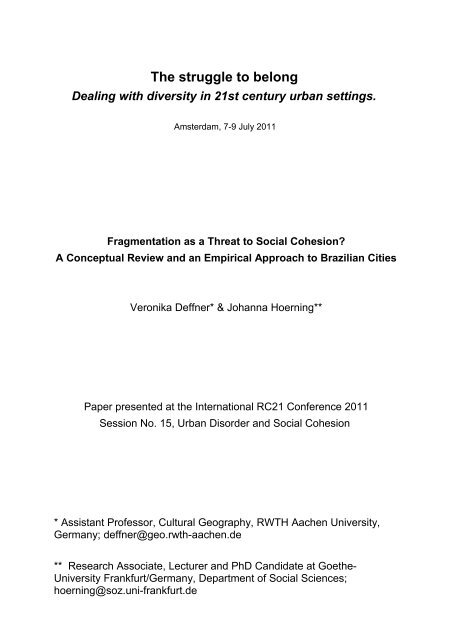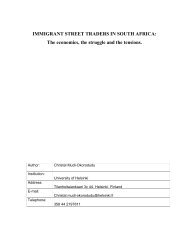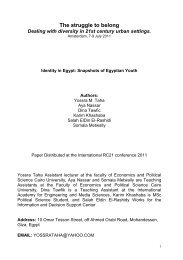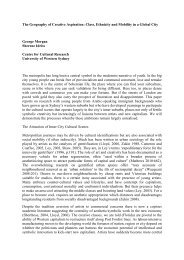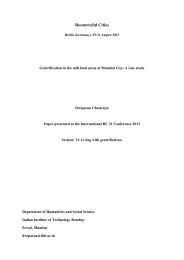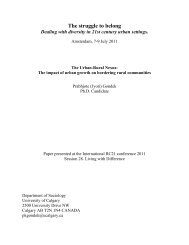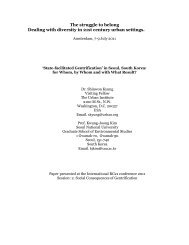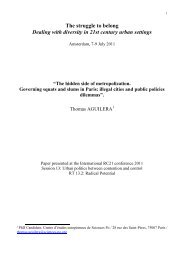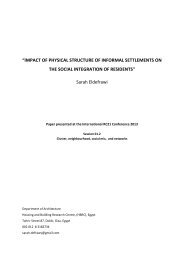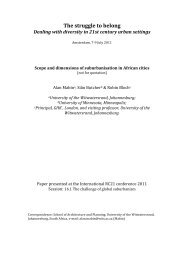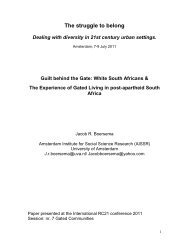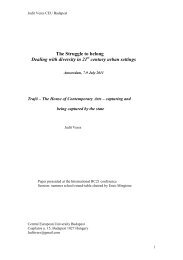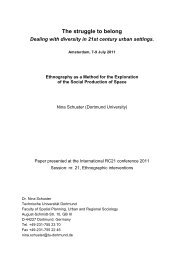Fragmentation as a threat to social cohesion - RC21 ORG ...
Fragmentation as a threat to social cohesion - RC21 ORG ...
Fragmentation as a threat to social cohesion - RC21 ORG ...
You also want an ePaper? Increase the reach of your titles
YUMPU automatically turns print PDFs into web optimized ePapers that Google loves.
The struggle <strong>to</strong> belong<br />
Dealing with diversity in 21st century urban settings.<br />
Amsterdam, 7-9 July 2011<br />
<strong>Fragmentation</strong> <strong>as</strong> a Threat <strong>to</strong> Social Cohesion?<br />
A Conceptual Review and an Empirical Approach <strong>to</strong> Brazilian Cities<br />
Veronika Deffner* & Johanna Hoerning**<br />
Paper presented at the International <strong>RC21</strong> Conference 2011<br />
Session No. 15, Urban Disorder and Social Cohesion<br />
* Assistant Professor, Cultural Geography, RWTH Aachen University,<br />
Germany; deffner@geo.rwth-aachen.de<br />
** Research Associate, Lecturer and PhD Candidate at Goethe-<br />
University Frankfurt/Germany, Department of Social Sciences;<br />
hoerning@soz.uni-frankfurt.de
<strong>Fragmentation</strong> <strong>as</strong> a Threat <strong>to</strong> Social Cohesion?<br />
A Conceptual Review and an Empirical Approach <strong>to</strong> Brazilian Cities<br />
Veronika Deffner & Johanna Hoerning<br />
Abstract<br />
Our paper reflects on urban fragmentation <strong>as</strong> a theoretically only poorly outlined and<br />
empirically hardly analyzed concept with regard <strong>to</strong> its production and perception in<br />
daily practices. When reviewing <strong>social</strong> science literature, the abundance of different<br />
usages of the term is striking, either related <strong>to</strong> the transformation of <strong>social</strong> structures<br />
and experience, or <strong>to</strong> morphological, terri<strong>to</strong>rial and geographical structures and how<br />
they again relate <strong>to</strong> <strong>social</strong> structures (in terms of socio-spatial analysis), <strong>as</strong> well <strong>as</strong><br />
decentralizing changes in power relations. Urban fragmentation h<strong>as</strong> <strong>to</strong> be queried <strong>as</strong><br />
both a process of deconstructing the perception of a former urban 'entirety' and of<br />
reconstructing a fragmentary urban space, <strong>as</strong> well <strong>as</strong> the fragmentary state of<br />
interwovenness of those parts that form urban societies and their space. In drawing<br />
upon Brazilian cities and the perception of favel<strong>as</strong> <strong>as</strong> 'disordering fragments', we will<br />
develop a perspective that seeks <strong>to</strong> combine the analysis of fragmentation <strong>as</strong> a<br />
perceived <strong>threat</strong> with a focus on daily <strong>social</strong> practice. This, we believe, is an<br />
important t<strong>as</strong>k of research <strong>to</strong> understand fragmentation which, so far, h<strong>as</strong> been<br />
generally outlined from the viewpoint of globalizing networks and the isolation of<br />
urban elites, where favel<strong>as</strong> are being constructed <strong>as</strong> the 'rest' or <strong>threat</strong>ening 'other'.<br />
Concerning Brazilian favel<strong>as</strong>, we may conclude that their disconnection lies in the<br />
fact that their inhabitants pursue lifestyles and life choices (e.g. leisure time, <strong>social</strong><br />
networks) that are very focused on the favela's space, where<strong>as</strong> interwovenness is<br />
primarily produced in economic and work-related <strong>as</strong>pects.<br />
Current debates on urban realities claim that <strong>to</strong>day’s cities suffer from ongoing<br />
processes of fragmentation. As an operational term, urban fragmentation is used by<br />
scientists <strong>to</strong> describe the phenomenon of incre<strong>as</strong>ingly differentiated societal and<br />
spatial polarization within cities, which seems yet difficult <strong>to</strong> gr<strong>as</strong>p or <strong>to</strong> calculate in its<br />
further dimensions and effects. Thus, fragmentation seems <strong>to</strong> represent a <strong>threat</strong> <strong>to</strong><br />
<strong>social</strong> cohesiveness on a political-planning <strong>as</strong> well <strong>as</strong> on a subjective-perceptive<br />
level. Our paper starts from the <strong>as</strong>sumption that the concept of urban fragmentation<br />
is theoretically only poorly outlined so far and empirically hardly analyzed with regard<br />
<strong>to</strong> its production and perception in daily practices. To point out the potentials and<br />
pitfalls of the term, we start by reviewing the conceptualizations within sociological<br />
and geographical research, and their empirical relevance for the understanding of<br />
cities <strong>as</strong> <strong>social</strong>ly constructed products.<br />
Concerning urban societies, the “fragmented city” seems <strong>to</strong> replace terms like the<br />
“dual/divided city” or the “quartered city”, but it is unclear if this fragmentation is seen<br />
<strong>to</strong> be the new structural socio-spatial form, or if it is a mere temporary and auxiliary<br />
term for a process which is <strong>threat</strong>ening us by its new complexity due <strong>to</strong> the sizes of<br />
cities <strong>to</strong>day. Within this context, we seek <strong>to</strong> combine geographical and sociological<br />
approaches, <strong>as</strong> we believe the disciplinary disconnection <strong>to</strong> be a source of the<br />
1 Deffner, Hoerning: <strong>Fragmentation</strong> <strong>as</strong> a Threat <strong>to</strong> Social Cohesion?
ambiguity of the term. As a new analytical term, the theoretical and empirical validity<br />
of fragmentation concerning <strong>social</strong>, economic, political, and spatial structures is not<br />
yet clear. To shed some light on the term <strong>as</strong> a conceptual <strong>to</strong>ol, our paper addresses<br />
fragmentation empirically in the context of Brazilian cities, focusing on the daily life in<br />
its apparently most “<strong>threat</strong>ening fragments”, the favel<strong>as</strong>. Thus, we will critically<br />
question if and how fragmentation is produced in daily <strong>social</strong> practice. Through their<br />
everyday-life practices, favela-dwellers connect different living and working realities<br />
(e.g. domestic workers, doormen). These de fac<strong>to</strong> existing different realities cannot<br />
be seen <strong>as</strong> disconnected, but must be analyzed with regard <strong>to</strong> their interrelations.<br />
Speaking of fragmentation, though, involves the risk of conceptualizing individual<br />
fragments by their disconnections rather than by their connections. Single fragments<br />
thereby are being evaluated differently in terms of their possible <strong>threat</strong> or not <strong>to</strong> <strong>social</strong><br />
order.<br />
1. Conceptual reflections – the fragment <strong>as</strong> witness/evidence, representation<br />
and indica<strong>to</strong>r<br />
Reviewing <strong>social</strong> science literature on the term or engaged with the phenomenon of<br />
fragmentation, the abundance of different usages is striking. Francoise Navez-<br />
Bouchanine (2002a, b) h<strong>as</strong> offered a rich overview of the his<strong>to</strong>ry of the term itself and<br />
the different forms of understanding. She distinguishes between approaches <strong>to</strong><br />
fragmentation <strong>as</strong> a general <strong>social</strong> or societal phenomenon, the fragmentation of<br />
urban form <strong>as</strong> a physical-spatial and <strong>as</strong> a socio-spatial phenomenon, and political<br />
fragmentation (Navez-Bouchanine 2002b). In the first c<strong>as</strong>e, we might think of<br />
fragmentation <strong>as</strong> a new or newly accentuated term for <strong>social</strong> structures. The second<br />
and third relate <strong>to</strong> morphological, terri<strong>to</strong>rial or geographical structures and how they<br />
again relate <strong>to</strong> <strong>social</strong> structures. The fourth, sociologically speaking, analyzes<br />
decentralizing changes in power relations. If we look at the current <strong>to</strong>pics or fields of<br />
<strong>social</strong> science research that refer <strong>to</strong> fragmentation <strong>as</strong> one of the defining<br />
characteristics and that coincide in a number of ways, we may find four main are<strong>as</strong>:<br />
research on globalization, on new media and the so-called information society, urban<br />
studies, and development theory. Still, fragmentation is not a new term – it appears<br />
<strong>to</strong>gether with conceptualizations of pluralization and differentiation of modern<br />
societies long before it experienced a renaissance within theorizations of late, radical<br />
or reflexive modernity and post-modernities.<br />
When dealing with a term that suffers from multiple usage and seems so difficult <strong>to</strong><br />
gr<strong>as</strong>p, it comes <strong>as</strong> a useful <strong>to</strong>ol <strong>to</strong> reflect upon its etymology <strong>to</strong> concentrate on its<br />
original meaning, in order <strong>to</strong> avoid connotations or metaphorical meanings for a<br />
moment: Fragment (Latin fragmentum), of course, means “broken piece”, <strong>to</strong> fragment<br />
(Latin frangere) “<strong>to</strong> fall <strong>to</strong> pieces”, or simply “<strong>to</strong> break”. <strong>Fragmentation</strong>, therefore,<br />
refers <strong>to</strong> both, the fragment <strong>as</strong> a result of the cleavage and the process of breaking<br />
in<strong>to</strong> pieces. The fragment appears <strong>as</strong> part of an original entity which may no longer<br />
appear <strong>as</strong> such. There is, we might conclude, a dialectic relation between<br />
deconstruction and reconstruction (Brunner 1997, 13), the fragment evidencing a<br />
former, deconstructed entity, representing a current state or at le<strong>as</strong>t its perception,<br />
and indicating a process of reconstructing a newly emerging pattern. The connecting<br />
<strong>as</strong>pect between p<strong>as</strong>t, present and future is (<strong>social</strong>) heterogeneity: it may not only be<br />
seen <strong>as</strong> a consequence of fragmentation, but also <strong>as</strong> its cause (cf. Holtz-Bacha<br />
1998).<br />
2 Deffner, Hoerning: <strong>Fragmentation</strong> <strong>as</strong> a Threat <strong>to</strong> Social Cohesion?
Research on fragmentation should, therefore, correlate these three elements, a<br />
former entity, a current perception, and an emerging pattern. If both, the<br />
deconstructing process and its consequent pattern, may be seen <strong>as</strong> fragmentary, will<br />
depend on <strong>social</strong> practice. Where the former entity is perceived <strong>as</strong> fragmented,<br />
deconstructed, non-existing, an emerging pattern is being reconstructed in daily<br />
<strong>social</strong> practice. Cl<strong>as</strong>sic sociological approaches on <strong>social</strong> structuring have related <strong>to</strong><br />
fragmentation <strong>as</strong> a process of disordering, in the sense of a dismantling and a<br />
disaggregation of formerly coherent societal structures. <strong>Fragmentation</strong> may either<br />
appear <strong>as</strong> a temporary re-structuring with fragments <strong>as</strong> remnants of former<br />
structures, or <strong>as</strong> an intrinsic process of incre<strong>as</strong>ingly polarized modern (and postmodern)<br />
societies with fragments <strong>as</strong> both, highly interrelated and disconnected parts<br />
of society <strong>as</strong> a whole. In the first c<strong>as</strong>e, fragmentation <strong>as</strong> a term is related <strong>to</strong> a lack of<br />
understanding of newly emerging structures. In the second, it seems <strong>to</strong> disguise or<br />
negate hierarchical structures of society, which have <strong>to</strong> be analyzed in their specific<br />
power-related capacities and the <strong>social</strong> significance of spatial production. The central<br />
question is whether fragmentation may be seen <strong>as</strong> the new pattern underlying sociospatial<br />
structures or even <strong>as</strong> the new mode of societal differentiation? We claim that<br />
the answer may only be found by analyzing daily <strong>social</strong> practice <strong>as</strong> related <strong>to</strong> but not<br />
coincident with perception and discursive narratives. <strong>Fragmentation</strong> <strong>as</strong> a term should<br />
not obscure hierarchies and inequalities of <strong>social</strong> heterogeneity, but help <strong>to</strong><br />
analytically distinguish disconnections and interwovenness of societal parts that differ<br />
in terms of their power <strong>to</strong> manipulate socio-spatial structures and patterns, even<br />
though they may all be essential <strong>to</strong> their daily production. It is, thus, the dialectic<br />
relationship between deconstruction and reconstruction, <strong>as</strong> well <strong>as</strong> between<br />
connection and disconnection, that underlies the analytical potential of the term.<br />
2. On fragmentation within sociological and geographical thought<br />
Social heterogeneity is an elementary characteristic of <strong>social</strong> structures, a structure<br />
comprising different, but interrelated parts (Blau 1977, 2). Hence, the t<strong>as</strong>k of<br />
sociological analysis is <strong>to</strong> understand and explain processes of distinction and<br />
connection that produce and reproduce certain <strong>social</strong> structures.<br />
Cl<strong>as</strong>sic sociological analyses have described <strong>social</strong> structures from a macroperspective<br />
<strong>as</strong> evolving from segmentary <strong>to</strong> differentiated societies (Durkheim 1977<br />
[1893]), but the differentiation of modern societies h<strong>as</strong> been unders<strong>to</strong>od from<br />
different angles and levels of analysis in numerous ways: <strong>social</strong> cl<strong>as</strong>ses and strata,<br />
functional and rational differentiation, <strong>social</strong> milieus and lifestyles, <strong>to</strong> name the most<br />
prominent. There h<strong>as</strong> been, though, a tendency <strong>to</strong> describe <strong>social</strong> structures <strong>as</strong><br />
incre<strong>as</strong>ingly fragmented, breaking up the former <strong>social</strong>, cultural, economic and<br />
political fractions of society. This “radicalization” of pluralization (Welsch 2002) in<br />
terms of values, attitudes and possible choices, interwoven with economic<br />
restructuring in the second half of the 20 th century, h<strong>as</strong> even lead <strong>to</strong> the <strong>as</strong>sumption,<br />
that within this postmodern condition, meta-narratives were no longer credible<br />
(Lyotard 1984). Even though the descriptions of pluralizing and fragmentizing <strong>social</strong><br />
worlds are in some way consensual, their interpretation varies <strong>to</strong> a great extent.<br />
Consequently, fragmentation w<strong>as</strong> becoming the new paradigm also in development<br />
studies, after the failing of the grand theories (Menzel 1992). The geographer Fred<br />
Scholz introduced the term at the end of the 1990ies with his Theory of Fragmented<br />
Development in the German-speaking disciplinary debate. <strong>Fragmentation</strong> in this<br />
sense is perceived <strong>as</strong> a new principle of structuration caused by economic, political<br />
3 Deffner, Hoerning: <strong>Fragmentation</strong> <strong>as</strong> a Threat <strong>to</strong> Social Cohesion?
and <strong>social</strong> transformation processes taking place in the so called “Second Modernity”<br />
(liberalization, deregulation, privatization of markets and a polarizing division of labor<br />
<strong>as</strong> a consequence of global capitalism, etc.) (Scholz 2004, 7). Within this<br />
perspective, fragmentation appears <strong>as</strong> a new form of segregation on a larger scale. It<br />
replaced the term polarization, due <strong>to</strong> the new complexity of socio-spatial, <strong>as</strong> well <strong>as</strong><br />
functional units of varying size, which are being established in the midst of a<br />
differentiated environment, often hermetically sealing themselves off against such<br />
dissimilar surroundings. In contr<strong>as</strong>t <strong>to</strong> the term 'polarization', which points <strong>to</strong> the<br />
juxtaposition of the irreconcilable, 'fragmentation' represents the recognition of<br />
contr<strong>as</strong>ting, but highly interwoven elements.<br />
These variations are mostly related <strong>to</strong> the question whether fragmentation is <strong>to</strong> be<br />
seen <strong>as</strong> opposed <strong>to</strong> integration (which generally is believed <strong>to</strong> be a “good” thing) and<br />
even questioning <strong>social</strong> <strong>cohesion</strong>, or if fragmentation leads <strong>to</strong> different, multiple forms<br />
of integration that may no longer be described solely in the notions of <strong>social</strong> and<br />
systemic integration resting upon – <strong>as</strong> most sociological concepts – nationally formed<br />
societies. The central term for describing new forms of integration is that of networks<br />
and it is closely linked <strong>to</strong> debates on the so-called information society, b<strong>as</strong>ed on new<br />
techniques and modes of communication. Within the latter, emph<strong>as</strong>is is being laid on<br />
its ambivalence between convergence, <strong>as</strong> “a similarity and incre<strong>as</strong>ing unity of<br />
experience” and fragmentation, <strong>as</strong> “a growing differentiation of experience” (Ludes<br />
2008, 10). Where<strong>as</strong> this view emph<strong>as</strong>izes individual experience <strong>as</strong> b<strong>as</strong>ed on modes<br />
of communication, the so-called network society thesis (C<strong>as</strong>tells 2001 [1996]) refers<br />
<strong>to</strong> a “widening gap between connected and unconnected (or disconnected) places<br />
and people” (Coutard 2008, 1816). Even though the term 'network' itself seems <strong>to</strong><br />
elude spatial fixes, within this conceptualization it is closely linked <strong>to</strong> places by<br />
technical and locally concentrated communication infr<strong>as</strong>tructures. This notion h<strong>as</strong> <strong>to</strong><br />
be distinguished <strong>to</strong> a certain extent from the b<strong>as</strong>ic concept of <strong>social</strong> networks which<br />
conceptualizes interrelations between individuals or <strong>social</strong> ac<strong>to</strong>rs and creates a<br />
significant world of its own without depending on interrelations with its surrounding<br />
world (Fuchs 2010, 56). In C<strong>as</strong>tell's network society, the network is b<strong>as</strong>ed on global<br />
financial flows, formed by nodes like share markets, political institutions, local<br />
production units and service centers and their underlying communication<br />
infr<strong>as</strong>tructure (C<strong>as</strong>tells 2001 [1996], 528). Where<strong>as</strong> the network emph<strong>as</strong>izes global<br />
connection, this new spatial arrangement produces local disconnection, a tendency<br />
seen most vigorously in so called mega-cities by C<strong>as</strong>tells (ibid., 460).<br />
The opposition between fragmentation and integration is central <strong>to</strong> analyses of<br />
globalization. At first sight, the globalization thesis links much more <strong>to</strong> the promise of<br />
a largely integrated world and the hypothesis of a world society, b<strong>as</strong>ed not only on<br />
economic relations, but also on political and cultural convergences, enabled by<br />
communication technologies and greater mobility, thereby eliminating obstacles<br />
posed by (geographical, spatial) distances. It is, thus, the grand meta-narrative that<br />
emerges simultaneously <strong>to</strong> the claim of the incredulity of such by postmodernist<br />
theorists (Harrison 2003, 13). Dealing with this apparent paradox (Menzel 1998) h<strong>as</strong><br />
become one of the big t<strong>as</strong>ks in globalization studies. There are, at le<strong>as</strong>t, two sides <strong>to</strong><br />
the opposition of fragmentation and integration within globalization analyses: One<br />
refers <strong>to</strong> the fact that “fragmentation is not used <strong>as</strong> a counter-argument or <strong>as</strong> a sign<br />
of the limits of the globalization processes. Rather, it is used <strong>to</strong> explain the dynamics<br />
of these processes. The more connected and consolidated the global network<br />
becomes, that is, the more integrated the 'globalized world', the more fragmented<br />
and disconnected becomes the 'non-globalized world' – all those countries and cities<br />
4 Deffner, Hoerning: <strong>Fragmentation</strong> <strong>as</strong> a Threat <strong>to</strong> Social Cohesion?
that are not part of the global network.” (Kozak 2008, 244). From this point of view,<br />
there is a seemingly irreconcilable divide between global networks and the “rest”.<br />
Another perspective relates more <strong>to</strong> the interrelations between globalizing and<br />
localizing tendencies in terms of “challeng[ing] the hegemony of globalization<br />
discourse […] [by] confront[ing] it with the empirical reality of multiple local outcomes”<br />
(Harrison 2003, 14).<br />
<strong>Fragmentation</strong> within these debates is often seen <strong>as</strong> the “’natural’ counterpart of<br />
globalization”, therefore “a status of the globalized world, which does not comprise<br />
the chance of reintegration and re-inclusion, which no longer concedes any way back<br />
from exclusion <strong>to</strong> inclusion” (Tröger 2009, 258). This argument of an irreversible<br />
exclusion appears convincingly concise and became quite successful <strong>as</strong> a new<br />
conceptual approach in geographical research (Scholz 2004). But the binary logic of<br />
connection and disconnection h<strong>as</strong> <strong>to</strong> be analyzed more carefully. <strong>Fragmentation</strong><br />
highly consists of connectivity due <strong>to</strong> the worldwide networking in different spheres<br />
(<strong>social</strong>, economical, political). Thus, we cannot speak in general of a non-reversible<br />
non-connectivity. We would rather suggest <strong>to</strong> speak of a new <strong>as</strong>ymmetrical<br />
integration from where new patterns of unjust spaces are emerging.<br />
3. Urban fragmentation<br />
It is the disparity between the connectivity of global networks and relationships and<br />
the disconnectedness on a local level that shifts the attention <strong>to</strong> the city, where the<br />
articulation between the global and the local is <strong>as</strong>sumed <strong>to</strong> lead <strong>to</strong> intensified<br />
fragmentation (Harrison 2003, 15). Navez-Bouchanine (2002b) distinguishes<br />
between different forms of fragmentation of urban form, <strong>as</strong> well <strong>as</strong> of socio-spatial<br />
fragmentation within cities. Concerning urban form, she shows that literature on the<br />
spatio-morphological fragmentation of cities draws much upon the notion of chaos <strong>as</strong><br />
a result of this process of fragmentation. It is the detachment of different parts and<br />
the establishment of internal boundaries that break with the city (planned and<br />
thought) <strong>as</strong> an entity and lead <strong>to</strong> “juxtapositions of very limited and confined, <strong>social</strong>ly<br />
specialized spaces” (Navez-Bouchanine 2002b, 57, translation JH). From another<br />
angle, fragmentation of urban form is unders<strong>to</strong>od <strong>as</strong> a disorderly process of<br />
development that leads <strong>to</strong> the splintering of urban space and makes the city a mosaic<br />
without a distinguishable centrality. Finally, others have analyzed this process not so<br />
much <strong>as</strong> a disorderly, but <strong>as</strong> a haphazard multipolarization, leading <strong>to</strong> an irregular,<br />
fractal morphology without a comprising order. So, there seems <strong>to</strong> be an almost<br />
consensual view that fragmentation h<strong>as</strong> something <strong>to</strong> do with disordering or undoing<br />
of the planned city, leading <strong>to</strong> chaotic or mosaic structures.<br />
From a sociological point of view, one of the central questions is <strong>to</strong> what extent<br />
fragmentation differs from other forms of segregation. As one of the central research<br />
fields of urban sociology, segregation refers <strong>to</strong> the establishment of <strong>social</strong>ly distinct<br />
and more or less homogenous (residential, functional) units within the city. As<br />
Francoise Navez-Bouchanine points out, there are at le<strong>as</strong>t two elements that<br />
distinguish fragmentation from segregation: On the one hand, “fragmentation<br />
cl<strong>as</strong>sifies the breaking, the reversal, the rupture with a <strong>social</strong> and political ensemble,<br />
where<strong>as</strong> segregation appears <strong>as</strong> a principal of hierarchical, but unitary organization”<br />
(Navez-Bouchanine 2002b, 62, translation JH). Residential segregation – referring <strong>to</strong><br />
a <strong>social</strong>ly homogenous neighborhood – is therefore shown <strong>to</strong> be obsolete against the<br />
background of fragmentation where the neighborhood is seen <strong>as</strong> “space of difference<br />
rather than of commonality” (Momma<strong>as</strong> 1996, 209). On the other hand,<br />
5 Deffner, Hoerning: <strong>Fragmentation</strong> <strong>as</strong> a Threat <strong>to</strong> Social Cohesion?
fragmentation refers much more <strong>to</strong> a transformation of public spaces than that of<br />
residential spaces (Navez-Bouchanine 2002b, 62). Here, an important field of<br />
research considers the privatization and surveillance of public spaces <strong>as</strong> one of the<br />
defining elements of the fragmentary city (e.g. Siebel/Wehrheim 2003). Fear and<br />
insecurity are also seen <strong>as</strong> the main driving forces <strong>to</strong> privatization and gating,<br />
probably the most elaborated empirical reference <strong>to</strong> fragmentation studies (e.g. Low<br />
2005). These, obviously, relate fragmentation <strong>to</strong> a cl<strong>as</strong>sic view of segregation, where<br />
<strong>social</strong>ly homogenous residential units characterize urban space. <strong>Fragmentation</strong> in<br />
this sense emph<strong>as</strong>izes the disconnection and exclusivity of distinct elite residential<br />
units and serves more <strong>as</strong> a description of their fortification. Within approaches that<br />
seek <strong>to</strong> cl<strong>as</strong>sify fragmentation <strong>as</strong> the new socio-spatial pattern of cities (e.g., “microfragmentation”,<br />
according <strong>to</strong> Caldeira, 1996, or “multi-fragmentation”, according <strong>to</strong><br />
Fischer/Parnreiter, 2002), it remains mostly unclear how this is supposed <strong>to</strong><br />
characterize a qualitative shift in the socio-spatial organization of cities. Rather, these<br />
approaches relate <strong>to</strong> fiercer or smaller-scale segregation and a resulting higher grade<br />
of complexity. The analytical and qualitative shift, though, <strong>as</strong> h<strong>as</strong> been shown in the<br />
conceptual reflection of fragmentation, lies within its dialectic of connection and<br />
disconnection, or, deconstruction and reconstruction.<br />
Probably the most overarching theoretical concept <strong>to</strong> <strong>social</strong> science literature on<br />
urban fragmentation is that of postmodern urbanism. Notions such <strong>as</strong> the “splintering<br />
metropolis” (Graham 2001) or the “fractal city” (Soja 2000) relate <strong>to</strong> this conceptual<br />
context. Key elements within the different approaches <strong>to</strong> this field of research are<br />
“spatial fragmentation and disaggregation” (Murray 2004, 142), mostly within multicentered<br />
urban regions (Soja 2000), characterized by a “pluralization of former<br />
collective identities” (Momma<strong>as</strong> 1996, 209) and/or the fact that “urban <strong>social</strong> order<br />
can no longer be defined effectively by such conventional and familiar modes of<br />
<strong>social</strong> stratification <strong>as</strong> the cl<strong>as</strong>s-divided Dual City of the bourgeoisie and the<br />
proletariat; the neatly layered Hierarchical City of the wealthy, the middle cl<strong>as</strong>s, and<br />
the poor; or the 'two Americ<strong>as</strong>' Racially Divided City of black versus white” (Soja<br />
2000, 265). Politically, this is not only related <strong>to</strong> the breaking up of cl<strong>as</strong>s-b<strong>as</strong>ed<br />
political affiliations (Momma<strong>as</strong> 1996, 210), but also <strong>to</strong> a shift <strong>to</strong> neoliberal modes of<br />
urban governance (Murray 2004, 142).<br />
In urban geographical research the phenomenon of fragmentation appears mainly <strong>as</strong><br />
socio-spatial fragments (e.g. spaces of exclusion versus spaces of inclusion),<br />
physical-material spaces (e.g. style of housing) or <strong>as</strong> diverse spatial functions (e.g.<br />
spaces for living, consumption or leisure). Within the discipline of geography, urban<br />
fragmentation is often limited <strong>to</strong> determining the polarization of “poor” and “wealthy”<br />
or <strong>to</strong> analyzing access possibilities <strong>to</strong> public or private spaces (especially privatized,<br />
formerly public spaces). Generally, the visible spatial structures are particularly<br />
important <strong>as</strong> they are a product of political, economic or <strong>social</strong> fac<strong>to</strong>rs (e.g. changing<br />
lifestyles, living arrangements and preferences, consumption patterns, etc.). Thus,<br />
fragmentation is mainly used in the sense of connected or disconnected/excluded<br />
parts of the city or society.<br />
At the end of the 1990s, urban geography conducted a conceptual shift <strong>to</strong>wards a<br />
more political perspective. The correlations between urban planning and society, and<br />
the new debates about the interdependency of fragments formerly considered <strong>as</strong><br />
isolated were identified <strong>as</strong> the essential issues for understanding cities. The focus of<br />
interest shifted <strong>to</strong> the finding that the built fortification of some parts of the city<br />
endangers <strong>social</strong> <strong>cohesion</strong>. Therefore, it became clear that not the perception of a<br />
6 Deffner, Hoerning: <strong>Fragmentation</strong> <strong>as</strong> a Threat <strong>to</strong> Social Cohesion?
fragmented physical structure but the fragmentation of the political organization of<br />
space (Gl<strong>as</strong>ze et al. 2005) w<strong>as</strong> <strong>threat</strong>ening urban entirety.<br />
Still, the urban geographical research, specifically speaking of fragmentation,<br />
primarily focused on the phenomenon of gated communities in different cultural<br />
contexts. “The other side”, i.e. the deprived or marginalized zones of the urban<br />
undercl<strong>as</strong>s were mainly neglected in empirical research, in spite of its weight for the<br />
urban and societal entirety. Though these fragments are representing the far larger<br />
part of urban societies and cities <strong>to</strong>day, they are covered behind the denomination of<br />
an anonymous m<strong>as</strong>s, like a “Planet” (Davis 2007), labeled by its status of poverty or<br />
being subaltern.<br />
In drawing upon Brazilian cities and the perception of favel<strong>as</strong> <strong>as</strong> “disordering<br />
fragments”, we will develop a perspective that seeks <strong>to</strong> combine the analysis of<br />
fragmentation <strong>as</strong> a perceived <strong>threat</strong> with a focus on daily <strong>social</strong> practice. This, we<br />
believe, is an important t<strong>as</strong>k of research <strong>to</strong> understand fragmentation which, so far,<br />
h<strong>as</strong> been generally outlined from the viewpoint of globalizing networks and the<br />
isolation of urban elites, where favel<strong>as</strong> are being constructed <strong>as</strong> the “rest” or<br />
<strong>threat</strong>ening “other”. Focusing on the production of space in everyday practice helps,<br />
according <strong>to</strong> Edward Soja (2010, 31), “<strong>to</strong> ground the search for spatial justice in<br />
<strong>social</strong>ly produced contexts rather than letting it float in idealized abstractions and <strong>to</strong>o<br />
e<strong>as</strong>ily deflected calls for universal human rights or radical revolution.”<br />
4. Favel<strong>as</strong> and the <strong>social</strong> production of (uneven) spaces<br />
Favel<strong>as</strong> are widely known and quoted in urban research <strong>as</strong> a symbol for the sociospatial<br />
segregation of Brazil's larger cities (Valladares 2002, 213). Apparently they<br />
are the visible proof for the “divided city” (“cidade partida”, Ventura 1994),<br />
representing the informal part of the urban society and economy.<br />
Favel<strong>as</strong>, or slums <strong>as</strong> they are often misleadingly called, are mainly known <strong>as</strong> the<br />
quarters of the urban poor. They are the living quarters for at le<strong>as</strong>t a third of Brazil's<br />
urban population. People who live there form the lower cl<strong>as</strong>s, and <strong>social</strong> mobility is<br />
rather restricted, which means that those who are born in<strong>to</strong> these socio-spatial<br />
arrangements are those who form and reproduce them throughout their lives. They<br />
provide the greater city with a large workforce on a minimal per-capita income.<br />
Without them, urban life <strong>as</strong> it is now would ce<strong>as</strong>e <strong>to</strong> exist. As Beatriz Jaguaribe<br />
(2007, 100) characterizes in her considerations about the phenomenon of favel<strong>as</strong>,<br />
they<br />
…“are an overwhelming feature of city life in Brazil. The contradic<strong>to</strong>ry relations<br />
between the favela and the city constitute a key issue of the Brazilian urban<br />
experience because they translate how the expectations of the modern<br />
metropolis have been both frustrated and partially fulfilled. They have been<br />
defeated because the material promise of modernity <strong>as</strong> access <strong>to</strong> goods and<br />
services h<strong>as</strong> been undermined by the radical economic and <strong>social</strong> inequality<br />
between the rich and the poor. Yet, they have been also enacted because the<br />
modernizing urban scenario is a crucial site for the invention of new forms of<br />
<strong>social</strong> identity, democratic struggle, and individual <strong>social</strong> mobility“.<br />
On first sight, this means that favel<strong>as</strong> are economically highly interrelated with other<br />
socio-spatial units in Brazilian cities and may not be characterized <strong>as</strong> disconnected<br />
fragments of a segmented urban economy. Still, they are perceived <strong>as</strong> somehow<br />
disconnected or detached fragments. To examine this ambiguity more closely, we<br />
7 Deffner, Hoerning: <strong>Fragmentation</strong> <strong>as</strong> a Threat <strong>to</strong> Social Cohesion?
may distinguish between two kinds of <strong>social</strong> production of the favela: a “materialist<br />
production” and a “discursive production”. In their dialectic reciprocity they are<br />
essential <strong>to</strong> understand the production of the “fragmented city”.<br />
4.1 The materialist production of the Favela <strong>as</strong> “informal city”<br />
What we call the materialist production of space is the result of two production<br />
patterns: the “perceived” and “conceived” space, according <strong>to</strong> the terminology of<br />
Henri Lefebvre (2004 [1974]). Everyday practice, conceptual thoughts, images and<br />
perceptions of space are inscribed in<strong>to</strong> this kind of space, which is perceived then<br />
mostly <strong>as</strong> “naturalized” urban form. It is the production of the favela which appears in<br />
all its “otherness” compared <strong>to</strong> the notion of a formal city.<br />
Favel<strong>as</strong> are often <strong>as</strong>sociated with the „disorderly city“, a stigma that goes back <strong>to</strong> the<br />
illegal status of their initial emergence <strong>as</strong> informal settlements. The first favel<strong>as</strong> were<br />
created more than 100 years ago. For a long time, they eluded administrative<br />
planning. Generally, legal issues like land ownership have been settled in the<br />
meantime. Favel<strong>as</strong> are often incorrectly referred <strong>to</strong> <strong>as</strong> “slums”. However, they are<br />
neither slum are<strong>as</strong>, nor are they marked by disorganized, makeshift housing, but<br />
rather residential are<strong>as</strong> with permanent buildings, the homes of large parts of Brazil’s<br />
urban undercl<strong>as</strong>s. Due <strong>to</strong> low incomes, their residents do not have access <strong>to</strong> the<br />
housing market of the “proper” city.<br />
Favel<strong>as</strong> are considered informal urban settlements – in spite of the “formal” city<br />
depending on the services provided by favela residents. The urban undercl<strong>as</strong>s is<br />
used and accepted <strong>as</strong> an army of cheap labour. They clean homes, cook or guard<br />
office buildings and homes of the middle and upper cl<strong>as</strong>ses. Most of the favela<br />
dwellers spend more time in the residential are<strong>as</strong> of the rich, than in their own<br />
homes. By means of their work force, they incorporate the connections between<br />
these different <strong>social</strong> and socio-economic realities. They are physically present,<br />
though <strong>social</strong>ly excluded from that world, concerning their rights and chances in life.<br />
Further, they work in construction, do carrier services or are street vendors and<br />
thereby keep the urban economy going. The Brazilian geographer Mil<strong>to</strong>n San<strong>to</strong>s<br />
(2004) characterizes this <strong>as</strong> a “bipolarization without dualism” (“bipolarizacao, m<strong>as</strong><br />
nao dualismo”). He divides the city in developing countries viewing their economic<br />
activity in two interacting and interdependent circuits with different logics: the favela,<br />
<strong>as</strong> the urban space of poverty, thus represents the inferior circuit of the city. It faces<br />
and interacts with the superior circuit. From an economic point of view, the favel<strong>as</strong><br />
and their residents are thus fully (even if <strong>as</strong>ymmetrically) integrated in<strong>to</strong> urban<br />
society and urban economy. However, these vital parts of urban society are<br />
marginalized in terms of rights and <strong>social</strong> acceptance. 1<br />
The status of <strong>social</strong> acceptance of the favel<strong>as</strong> and their dwellers is reflected in the<br />
political and governmental attention. The political organization of space changed over<br />
the l<strong>as</strong>t decades from a policy of ignorance <strong>to</strong> a policy of acceptance. These policies<br />
relate <strong>to</strong> different strategies of control: Where<strong>as</strong> the former consisted of controlling by<br />
undoing (in the worst c<strong>as</strong>e by clearance), the current consists of active control<br />
strategies in combination with improvement strategies. Governmental and nongovernmental<br />
initiatives are slowly incre<strong>as</strong>ing <strong>to</strong> improve the living conditions in<br />
favel<strong>as</strong>. Even though favel<strong>as</strong> are no longer seen only <strong>as</strong> a problem, but also <strong>as</strong> a<br />
potential for urban society, they still are spaces of poverty (Valladares 2002, 214)<br />
1<br />
For a discussion of the term 'marginality' see Perlman 1976, 2006<br />
8 Deffner, Hoerning: <strong>Fragmentation</strong> <strong>as</strong> a Threat <strong>to</strong> Social Cohesion?
and confine their inhabitants <strong>to</strong> a different status of citizenship which keeps them<br />
from being equally integrated and connected. On this note, Edward Soja lines out in<br />
his reflections on the production of unjust geographies: “[E]very place on earth is<br />
blanketed with thick layers of macrospatial organization arising not just from<br />
administrative convenience but also from the imposition of political power, cultural<br />
domination, and <strong>social</strong> control over individuals, groups, and the places they inhabit”<br />
(Soja 2010, 32).<br />
4.2 The discursive production of the Favela <strong>as</strong> a “<strong>threat</strong> <strong>to</strong> urban society”<br />
The conception of spaces within a negative discourse, e.g. the stigma of the favel<strong>as</strong><br />
<strong>as</strong> violent or dangerous places, can lead <strong>to</strong> the establishment of a “suffered space”<br />
<strong>as</strong> the p<strong>as</strong>sive version of “lived space” (Lefebvre). To illustrate this subtle process we<br />
first have <strong>to</strong> understand the perceived negative significance of the favela for the city.<br />
Favel<strong>as</strong> appear <strong>to</strong> be a <strong>threat</strong> <strong>to</strong> urban order because they are commonly stigmatised<br />
<strong>as</strong> problematic are<strong>as</strong>, <strong>as</strong> places of danger, violence and crime. Brazil’s cities<br />
undeniably suffer from an extremely high level of violent crime. This is mainly a<br />
consequence of the high <strong>social</strong> disparities: “Since the 1980s, the incre<strong>as</strong>e of <strong>social</strong><br />
violence produced by the globalized drug trade and the flow of media images,<br />
consumer goods, and new cultural identities produced a crisis of representation of<br />
the 'national imagined community'”, <strong>as</strong> Jaguaribe (2007, 100) sums up.<br />
Favel<strong>as</strong> are thought of <strong>as</strong> the hotbeds of violent crime. This is especially true<br />
because violence is predominantly confined <strong>to</strong> the favel<strong>as</strong>, which means that crime<br />
and violence primarily affect the inhabitants themselves, especially black male<br />
adolescents. Most Brazilians from the middle and upper cl<strong>as</strong>ses have never been <strong>to</strong><br />
a favela. Supported by negative media coverage, these unknown zones e<strong>as</strong>ily<br />
become branded <strong>as</strong> suspicious and dangerous quarters. They represent<br />
au<strong>to</strong>nomous, ungovernable settlements. Thus, the favel<strong>as</strong> seem <strong>to</strong> be “a <strong>threat</strong>” <strong>to</strong><br />
the rest of urban society. They symbolize spaces that could imperil the surrounding<br />
“formal”, capitalist city. In other words the principles of neoliberalism and their ide<strong>as</strong><br />
of urban space cannot be applied <strong>to</strong> favel<strong>as</strong> <strong>as</strong> they do not combine with the logic of<br />
“modernity”. Seen only from this point of view, favel<strong>as</strong> do not so much appear <strong>to</strong> be<br />
disconnected fragments, but unconnected segments that follow an au<strong>to</strong>nomous logic.<br />
But there is another, far more important <strong>as</strong>pect that influences the inhabitants in<br />
coping with everyday life in the favela. It is their stigmatization and in particular its<br />
resulting subtle exclusionary practices. On the one hand, favela dwellers are already<br />
stigmatized by living in the favel<strong>as</strong>, these being considered the informal city. Socially<br />
and spatially they are separated <strong>as</strong> the “rest” from “the city”. They are conceived <strong>as</strong><br />
an obstacle <strong>to</strong> the urban community's <strong>social</strong> cohesiveness. Not even a change of<br />
policy, since the early 1990s, from uprooting <strong>to</strong> <strong>to</strong>lerating the favel<strong>as</strong> <strong>as</strong> part of<br />
Brazil's cities could s<strong>to</strong>p a large part of society from continuing <strong>to</strong> label them <strong>as</strong> an<br />
urban anomaly. Some also think of the favel<strong>as</strong> <strong>as</strong> being a transitional ph<strong>as</strong>e on the<br />
way <strong>to</strong> the “formal city”. This discourse implies that favel<strong>as</strong> are not entirely<br />
acknowledged <strong>as</strong> proper, integral parts of urban spaces. As a consequence,<br />
exclusion seems legitimate and conflict inevitable. Even if they are not any more<br />
regarded <strong>as</strong> “white stains” in the city maps and at le<strong>as</strong>t <strong>to</strong>lerated <strong>as</strong> inhabited spaces,<br />
they are not completely recognized <strong>as</strong> legitimate living are<strong>as</strong>. Therefore, faveladwellers<br />
are perceived rather <strong>as</strong> a disconnected segment of urban society. They<br />
have <strong>to</strong> suffer the stigmatization of their living spaces which represent the eyesore of<br />
the “broken”, because “uneven” modernity of Brazil’s cities (s. Jaguaribe 2007).<br />
9 Deffner, Hoerning: <strong>Fragmentation</strong> <strong>as</strong> a Threat <strong>to</strong> Social Cohesion?
On the other hand there is a <strong>social</strong> and racial stigmatization, which is closely related<br />
<strong>to</strong> the discrimination that living in the favela entails. These <strong>social</strong> and racial<br />
discrimina<strong>to</strong>ry practices lead <strong>to</strong> the fact that the inhabitants of the favel<strong>as</strong> are not<br />
being recognized <strong>as</strong> equal citizens, although this is a very subtle process.They are<br />
thought of <strong>as</strong> second cl<strong>as</strong>s citizens. Thus, they are not necessarily excluded from<br />
urban space, however they are excluded from urban society or restricted <strong>to</strong> living at<br />
the edge of society. Nevertheless the urban undercl<strong>as</strong>s actively participates in and<br />
exhibits the same value and consumption patterns <strong>as</strong> the rest of Brazil’s society. We<br />
also have <strong>to</strong> take in<strong>to</strong> account that the favel<strong>as</strong> represent enormous markets for the<br />
modern consumption pattern (Valladares 2004, 219). At the same time, their<br />
economic and political integration is <strong>as</strong>ymmetrical – integrally related <strong>to</strong> economic<br />
and political contexts by standards of their work force and their voting potential,<br />
<strong>social</strong> disparities go along with restricted possibilities in terms of <strong>social</strong> mobility.<br />
4.3 Coping strategies with everyday life in Favel<strong>as</strong><br />
The majority of the favela inhabitants have internalized their experiences with<br />
structural discrimination. As a consequence, they have a defensive and deprecating<br />
attitude <strong>to</strong>wards the government and higher <strong>social</strong> cl<strong>as</strong>ses. This method of selfpreservation<br />
protects them from more discrimina<strong>to</strong>ry experiences but subtly conceals<br />
the still existing inequalities. So, some of the main quotidian practices are adaptation<br />
<strong>to</strong> and acceptance of the given living circumstances, <strong>as</strong> the following quotations of<br />
favela dwellers express: 2<br />
“If I wouldn’t accept, it’s getting worse. You have <strong>to</strong> live with what you get. I w<strong>as</strong> born in this<br />
world, I don’t have another“ (doormen, 40 years old).<br />
“We are used <strong>to</strong> it. Though, I think this is the evil. If we wouldn’t get used <strong>to</strong> everything here a<br />
lot of all that bad things wouldn’t occur. Like that issue with blacks, our race... all that racism<br />
couldn’t happen… no prejudices. But racism is mostly here inside, against eachother”<br />
(housemaid, 50 years old).<br />
Most people from the undercl<strong>as</strong>s feel their <strong>social</strong> status and circumstances are selfinflicted.<br />
Especially when confronted with members of other <strong>social</strong> cl<strong>as</strong>ses, they see<br />
themselves <strong>as</strong> inferior and feel <strong>as</strong>hamed:<br />
“I’m not jealous. Sometimes I feel guilty, I’m blaming myself that I didn’t worked really hard<br />
enough <strong>to</strong> study, <strong>to</strong> be trained <strong>as</strong> something better <strong>to</strong> have better job opportunities”<br />
(housemaid, 22 years old).<br />
This feeling of humiliation is crucial <strong>to</strong> understanding the dominance of defensive<br />
patterns in their actions. Thus, reactive pragmatism is an essential way of coping with<br />
everyday life. This is obvious in the <strong>social</strong> relationships and how they deal with the<br />
restricted opportunities in their lives. Frustration is mainly taken out on their peers<br />
within the Favela. Therefore this already pragmatic community and its sense of<br />
<strong>to</strong>getherness is weakened considerably.<br />
Another important <strong>as</strong>pect, thereby, is the occurrence of interpersonal violence, for<br />
what the favel<strong>as</strong> are so strongly discriminated. What h<strong>as</strong> <strong>to</strong> be considered <strong>to</strong> this<br />
matter is that violence is mainly directed “inside”:<br />
“Here inside violence takes place. Because… the youth don’t know how <strong>to</strong> converse. If there<br />
is a quarrel, a dispute, they take the knife and kill eachother, or shot them down, just like that!<br />
That’s happening especially and mostly beyond themselves. It’s sad... but I think this is the<br />
only disadvantage here in our quarter.” (teacher of Capoeira, 30 years old).<br />
2<br />
The quotations originate from interviews conducted in the context of a PhD research project (2003-<br />
2008) in Salvador/Bahia (cf. Deffner 2010)<br />
10 Deffner, Hoerning: <strong>Fragmentation</strong> <strong>as</strong> a Threat <strong>to</strong> Social Cohesion?
The lifestyle and life choices (e.g. leisure time, <strong>social</strong> networks) of the inhabitants of<br />
the favel<strong>as</strong> are also – with the exception of work related <strong>as</strong>pects - very focused on<br />
the favela's space. The favela is a cosmos, in which the inhabitants can take on<br />
responsibility for themselves and organize their daily lives freely. Here they can deal<br />
with their everyday struggle for survival in their own way – without being confronted<br />
additionally with discrimination and humiliation.<br />
More than the stigma of the favel<strong>as</strong> <strong>as</strong> “disordered” fragments in the city, due <strong>to</strong> their<br />
formerly illegal character, the daily life of their inhabitants is afflicted with the<br />
reputation for being home <strong>to</strong> the drug scene and <strong>to</strong> ruthless and violent people. This<br />
negative spatial discourse of the favela <strong>as</strong> being a criminal, violent, and dangerous<br />
place is very powerful. It affects the organization of daily life and places constraints<br />
on living chances for the favela dwellers. Moreover, it helps <strong>to</strong> construct a subaltern<br />
citizenship that legitimizes their treatment <strong>as</strong> second cl<strong>as</strong>s citizens, especially in<br />
justice and law, where the practice of “punishing the poor”, referring <strong>to</strong> Loic<br />
Wacquant (2006), is still valid. Thus, the negative spatial discourse h<strong>as</strong> a powerful<br />
impact on the production and reproduction of unjust geographies.<br />
If we transfer Lefebvre’s ide<strong>as</strong> of the “right <strong>to</strong> the city” <strong>to</strong> the favela, it is obvious, that<br />
the inhabitants here do not have any chances of <strong>social</strong> mobility. Instead they live in<br />
their own micro-cosmos. This enforces the image of „the city within the city“ and<br />
supports the rest of society in their views, that the favela is an unknown, suspicious<br />
space. This externally enforced self-organization of the favel<strong>as</strong> again perpetuates the<br />
image of ungovernability <strong>to</strong> the outside world.<br />
But, we have <strong>to</strong> take in<strong>to</strong> account, that the favela is not a hermeneutic, separate city<br />
within the city. Favela dwellers are highly involved in the whole urban productivity<br />
system, they share the value patterns of global consumption, though being only<br />
partially able <strong>to</strong> participate. The formal and the informal city are strongly<br />
interdependent, one would ce<strong>as</strong>e <strong>to</strong> exist without the other. This also refers <strong>to</strong> the<br />
profitable drug traffic, which equally relies on its localization within the favel<strong>as</strong> and its<br />
main consumption within the upper cl<strong>as</strong>ses.<br />
4.4 Favel<strong>as</strong>: Segmented or fragmented urban spaces?<br />
Brazilian cities of <strong>to</strong>day show signs of incre<strong>as</strong>ed <strong>social</strong> dissociation, their critical<br />
junctures placing <strong>social</strong> stability at risk. They are <strong>social</strong>ly constructed along socioeconomic<br />
frontiers, and perceived <strong>as</strong> naturalized <strong>as</strong> a result of their perpetuated<br />
reproduction. Urban are<strong>as</strong> experiencing <strong>social</strong> conflict endanger the feeling of<br />
<strong>cohesion</strong> within a community. To unveil these underlying causes, we have <strong>to</strong> think of<br />
urban space <strong>as</strong> a political product influenced by the economy. We have <strong>to</strong> focus on<br />
inequalities that hinder people from entering other spaces and impede their decisions<br />
and opportunities in life. To consider space <strong>as</strong> a dimension of <strong>social</strong> inequality helps<br />
understand how it can be used <strong>as</strong> an instrument of power. Understanding the subtle<br />
effects of constructed space and decoding its <strong>social</strong> implications helps us <strong>to</strong><br />
comprehend why the differences in power do not ce<strong>as</strong>e <strong>to</strong> exist. They are usually<br />
attributed <strong>to</strong> economic potential and practices.<br />
The empirical reflections on favel<strong>as</strong> <strong>as</strong> integral parts of Brazilian cities show that they<br />
represent the dialectic relation between connection and disconnection. Favel<strong>as</strong> seem<br />
<strong>to</strong> neglect the order of an urban space that is constructed <strong>as</strong> a formal entity and<br />
deconstruct this formal entity by forming essential, but differently organized parts. As<br />
disconnected parts, they represent a possible <strong>threat</strong> <strong>to</strong> <strong>social</strong> order, which is<br />
11 Deffner, Hoerning: <strong>Fragmentation</strong> <strong>as</strong> a Threat <strong>to</strong> Social Cohesion?
enforced by their importance <strong>to</strong> the spatial organization of crime. In this sense,<br />
favel<strong>as</strong> are highly perceived and represented in debates on urban security and the<br />
res<strong>to</strong>ration of urban order. Within this logic, favel<strong>as</strong> have <strong>to</strong> be integrated and<br />
transformed in<strong>to</strong> “legal” places. On the other hand, their interwovenness is often<br />
neglected, because the maintenance of a cheap and legally subordinate work force is<br />
crucial <strong>to</strong> the maintenance of the economic order of the capitalist city. This is why the<br />
connections and disconnections of the favela interrelate and depend on each other –<br />
the favela being alternately constructed <strong>as</strong> both, interwoven and disconnected<br />
fragment, <strong>as</strong> well <strong>as</strong> a completely unconnected segment.<br />
5. Urban fragmentation <strong>as</strong> a <strong>threat</strong> <strong>to</strong> <strong>social</strong> <strong>cohesion</strong>?<br />
Speaking of fragmentation includes the danger that we are indirectly talking of<br />
fragments of order and disorder. Thus, we are following the binary code of being<br />
included or excluded from the whole spectrum of the urban. In this sense,<br />
fragmentation is a normative concept and focuses negatively on disconnections,<br />
rather than connections. As an analytical concept, fragmentation bears the potential<br />
of understanding newly emerging patterns of simultaneous disconnections and<br />
interwovenness. Relating <strong>to</strong> <strong>social</strong> <strong>cohesion</strong>, fragmentation <strong>as</strong> a state of socio-spatial<br />
patterns does not question <strong>cohesion</strong> – but certainly the process of fragmentation<br />
questions and deconstructs a socio-spatial order that h<strong>as</strong> been shaping cities for so<br />
long: functional segmentation and segregation. For further research, fragmentation<br />
should be made fruitful <strong>as</strong> a concept that helps <strong>to</strong> understand how <strong>social</strong> <strong>cohesion</strong> in<br />
<strong>to</strong>day's cities is being produced and reproduced, and which forms of <strong>as</strong>sociation and<br />
dissociation coexist.<br />
Still, we should bear in mind that fragmentary structures may neglect or hide<br />
hierarchical or vertical structures that impede certain connections – and lead <strong>to</strong><br />
segmentary cleavages. As for the two extremes, favel<strong>as</strong> and gated communities<br />
show certain <strong>as</strong>pects of strong segmentation even though depending on each other.<br />
To use fragmentation <strong>as</strong> a negative normative concept of dissolution and disorder<br />
means <strong>to</strong> give way <strong>to</strong> an elite bi<strong>as</strong>, neglecting the interwovenness of the so-called<br />
'formal' units with the 'informal' units and legitimizing fortification <strong>as</strong> a response <strong>to</strong> the<br />
'dangerous fragments'. As the analysis of Brazilian favel<strong>as</strong> h<strong>as</strong> shown,<br />
interwovenness is mostly given in economic and work-b<strong>as</strong>ed <strong>as</strong>pects, which includes<br />
the favela-located drug-economy. Distinction certainly is most accentuated in terms<br />
of socio-cultural <strong>as</strong>pects. We may not confuse them with an “elite culture” on the one<br />
side and a “culture of poverty” on the other. In this sense, fragmentation does allow<br />
for more careful distinctions, and certainly gives way <strong>to</strong> understanding more<br />
thoroughly how, and by what means, <strong>social</strong> spaces and their cultural <strong>as</strong>pects are<br />
being produced externally and internally by the <strong>social</strong> groups that form urban<br />
societies. They still produce one urban reality, however fragmented – simultaneously<br />
disconnected and interwoven – it may be.<br />
Bibliography<br />
Caldeira, T. P. do Rio (1992): City of Walls: Crime, Segregation, and Citizenship in Sao<br />
Paulo. Berkeley: University of California Press<br />
C<strong>as</strong>tells, M. (2001 [1996]), D<strong>as</strong> Informationszeitalter 1: Der Aufstieg der<br />
Netzwerkgesellschaft. Opladen: Leske+Budrich<br />
12 Deffner, Hoerning: <strong>Fragmentation</strong> <strong>as</strong> a Threat <strong>to</strong> Social Cohesion?
Coutard, O. (2008): Placing Splintering Urbanism: Introduction. In: Geoforum 39 (2008), pp.<br />
1815-1820<br />
Davis, M. (2007): Planeta Favela. São Paulo.<br />
Deffner, V. (2010): Habitus der Scham. Die soziale Grammatik ungleicher Raumproduktion.<br />
Eine sozialgeographische Untersuchung der Alltagswelt Favela in Salvador da Bahia<br />
(Br<strong>as</strong>ilien). P<strong>as</strong>sauer Schriften zur Geographie, 26. P<strong>as</strong>sau.<br />
Durkheim, E. (1977 [1893]), Über die Teilung der sozialen Arbeit. Frankfurt am Main:<br />
Suhrkamp<br />
Fischer, K. & C. Parnreiter (2002): Transformation und neue Formen der Segregation in den<br />
Städten Lateinamerik<strong>as</strong>. Geographica Helvetica 4/57, 245-252<br />
Fuchs, S. (2010): Kulturelle Netzwerke. Zu einer relationalen Soziologie symbolischer<br />
Formen. In: Fuhse, J. and S. Mützel (ed.): Relationale Soziologie. Zur kulturellen Wende der<br />
Netzwerkforschung. Wiesbaden: VS Verlag, pp. 49-68<br />
Gl<strong>as</strong>ze, G., Webster, C. & K. Frantz (ed.) (2005): Private Cities. Global and Local<br />
Perspectives. London: Routledge<br />
Graham, S. (2001), The Spectre of the Splintering Metropolis. In: Cities, 18:6, pp. 365-368<br />
Harrison, P. (2003): <strong>Fragmentation</strong> and Globalisation <strong>as</strong> the New Meta-Narrative. In:<br />
Harrison, P., M. Huchzermeyer and M. Mayekiso (ed.): Contronting <strong>Fragmentation</strong>: Housing<br />
and Urban Development in a Democratising Society. Cape Town: UCT Press, 13-25<br />
Holtz-Bacha, C. (1998): Fragmentierung der Gesellschaft durch d<strong>as</strong> Internet. In: Gellner, W.<br />
and von Korff, F. (ed.): Demokratie und Internet. Baden-Baden: Nomos, pp.219-226<br />
IBGE (Institu<strong>to</strong> Br<strong>as</strong>ileiro de Geografia e Estatistica – Brazilian Institute of Geography and<br />
Statistics) (2007): Sintese de Indica<strong>to</strong>res Sociais. Uma análise d<strong>as</strong> condições de vida da<br />
população br<strong>as</strong>ileira 2007. Rio de Janeiro.<br />
Jaguaribe, B. (2007): Cities without Maps. Favel<strong>as</strong> and the Astethics of Realism. In: Çinar, A.<br />
& T. Bender (ed.): Urban Imaginaries. Locating the Modern City. Minneapolis/London, pp.<br />
100-120<br />
Kozak, D. (2008): Assessing Urban <strong>Fragmentation</strong>: The emergence of new typologies in<br />
central Buenos Aires. In: Jenks, M., D. Kozak and P. Takkanor (ed.): World Cities and Urban<br />
Form. Fragmented, polycentric, sustainable? London: Routledge, 239-258.<br />
Lefebvre, H. (1968): Le droit á la ville. Paris.<br />
Lefebvre, H. (2000): La production de l’espace. Paris: Anthropos.<br />
Low, S. (2005): Towards a Theory of Urban <strong>Fragmentation</strong>: A Cross-Cultural Analysis of<br />
Fear, Privatization, and the State. In: Cybergeo: European Journal of Geography, Dossiers,<br />
Systemic impacts and sustainability of gated enclaves in the City. Pre<strong>to</strong>ria, South Africa,<br />
document 349<br />
Ludes, P. (2008), Introduction: Unity in Diversity. In: idem (ed.), Convergence and<br />
<strong>Fragmentation</strong>. Media Technology and the Information Society. Chicago: University of<br />
Chicago Press, pp. 9-24<br />
Lyotard, J.-F. (1984), The postmodern condition: A report on knowledge. Minneapolis:<br />
Minnesota University Press<br />
Menzel, U. (1992): D<strong>as</strong> Ende der Dritten Welt und d<strong>as</strong> Scheitern der Großen Theorie.<br />
Frankfurt am Main. Suhrkamp.<br />
Menzel, U. (1998): Globalisierung versus Fragmentierung. Frankfurt am Main: Suhrkamp.<br />
Momma<strong>as</strong>, H. (1996): Modernity, Postmodernity and the Crisis of Social Modernization: A<br />
C<strong>as</strong>e Study in Urban <strong>Fragmentation</strong>. In: International Journal on Urban and Regional<br />
Research 20/2, 196-216.<br />
Murray, M. J. (2004): The Spatial Dynamics of Postmodern Urbanism: Social Polarisation<br />
and <strong>Fragmentation</strong> in São Paulo and Johannesburg. In: Journal of Contemporary African<br />
Studies 22/2, 139-164.<br />
13 Deffner, Hoerning: <strong>Fragmentation</strong> <strong>as</strong> a Threat <strong>to</strong> Social Cohesion?
Navez-Bouchanine, F. (2002a): Emergence d’une notion: quelques repères his<strong>to</strong>riques. In:<br />
idem (ed.): La <strong>Fragmentation</strong> en Question: Des villes entre fragmentation spatiale et<br />
fragmentation <strong>social</strong>e? Paris: L’Harmattan, 19-44.<br />
Navez-Bouchanine, F. (2002b): La fragmentation: sources et ‘definitions’. In: ibidem, 45-103.<br />
Perlman, J. E. (1976): The Myth of Marginality: Urban Poverty and Politics in Rio de Janeiro.<br />
Berkeley: University of California Press<br />
Perlman, J. E. (2006): “The Metamorphosis of Marginality: Four Generations in the Favel<strong>as</strong><br />
of Rio de Janeiro, Annals. AAPSS. 605, May, 2006<br />
Queiros Ribeiro, de L.C. (ed.) (2004): Metrópoles. Entre coesão e a fragmentação, a<br />
cooperação e o confli<strong>to</strong>. São Paulo.<br />
San<strong>to</strong>s, M. (2004): O Espaço Dividido. Os dois circui<strong>to</strong>s da economia urbana dos países<br />
subdesenvolvidos. São Paulo.<br />
Scholz, F. (2004): Die Theorie der „fragmentierenden Entwicklung“. Geographische<br />
Rundschau 10/54, 6-11.<br />
Siebel, W. and J. Wehrheim (2003), Öffentlichkeit und Privatheit in der überwachten Stadt.<br />
In: DISP Nr. 153, pp.4-13<br />
Soja, E. W. (2000), Postmetropolis. Critical Studies of Cities and Regions. Oxford: Blackwell<br />
Soja, E. W. (2010): Seeking Spatial Justice. Minneapolis/London.<br />
Wacquant, L.J.D. (2005): The militarisation of urban marginality: lessons from the Brazilian<br />
metropolises. In: International Political Sociology, 2 (1), pp. 56-74.<br />
Tröger, S. (2009): Fragmented or included? – Impacts of globalization on Addis Ababa’s<br />
poor. In: Erdkunde, 63(3), pp. 257-268.<br />
Valladares, L. (2002): Favel<strong>as</strong>, mondialisation et fragmentations. In: Navez-Bouchanine, F.<br />
(ed.): La <strong>Fragmentation</strong> en Question: Des villes entre fragmentation spatiale et fragmentation<br />
<strong>social</strong>e? Paris: L’Harmattan, pp. 209-221.<br />
Ventura, Z. (1994): Cidade Partida. São Paulo: Companhia d<strong>as</strong> Letr<strong>as</strong>.<br />
Wacquant, L.J.D. (2006): Punishing the Poor. The New Government of Social Insecurity.<br />
Durham.<br />
Welsch, W. (2002), Unsere postmoderne Moderne. Berlin: Akademie Verlag<br />
14 Deffner, Hoerning: <strong>Fragmentation</strong> <strong>as</strong> a Threat <strong>to</strong> Social Cohesion?


